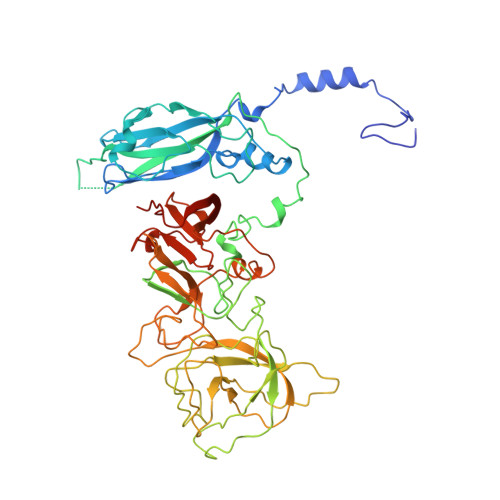The Cryo-EM Structure of Vesivirus 2117 Highlights Functional Variations in Entry Pathways for Viruses in Different Clades of the Vesivirus Genus.
Sutherland, H., Conley, M.J., Emmott, E., Streetley, J., Goodfellow, I.G., Bhella, D.(2021) J Virol 95: e0028221-e0028221
- PubMed: 33853966
- DOI: https://doi.org/10.1128/JVI.00282-21
- Primary Citation of Related Structures:
7BJP - PubMed Abstract:
Vesivirus 2117 is an adventitious agent that has been responsible for lost productivity in biopharmaceutical production following contamination of Chinese hamster ovary cell cultures in commercial bioreactors. A member of the Caliciviridae , 2117 is classified within the Vesivirus genus in a clade that includes canine and mink caliciviruses but is distinct from the vesicular exanthema of swine virus (VESV) clade, which includes the extensively studied feline calicivirus (FCV). We have used cryogenic electron microscopy (cryo-EM) to determine the structure of the capsid of this small, icosahedral, positive-sense-RNA-containing virus. We show that the outer face of the dimeric capsomeres, which contains the receptor binding site and major immunodominant epitopes in all caliciviruses studied thus far, is quite different from that of FCV. This is a consequence of a 22-amino-acid insertion in the sequence of the FCV major capsid protein that forms a "cantilevered arm" that both plays an important role in receptor engagement and undergoes structural rearrangements thought to be important for genome delivery to the cytosol. Our data highlight a potentially important difference in the attachment and entry pathways employed by the different clades of the Vesivirus genus. IMPORTANCE Vesivirus 2117 has caused significant losses in manufacturing of biopharmaceutical products following contamination of cell cultures used in their production. We report the structure of the vesivirus 2117 capsid, the shell that encloses the virus's genome. Comparison of this structure with that of a related vesivirus, feline calicivirus (FCV), highlighted potentially important differences related to virus attachment and entry. Our findings suggest that these two viruses may bind differently to receptors at the host cell surface. We also show that a region of the capsid protein of FCV that rearranges following receptor engagement is not present in vesivirus 2117. These structural changes in the FCV capsid have been shown to allow the assembly of a portal-like structure that is hypothesized to deliver the viral genome to the cell's interior. Our data suggest that the 2117 portal assembly may employ a different means of anchoring to the outer face of the capsid.
Organizational Affiliation:
Medical Research Council-University of Glasgow Centre for Virus Research, Glasgow, United Kingdom.














